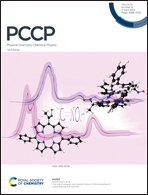The effective interfacial tensions between pure liquids and rough solids: a coarse-grained simulation study
Abstract
The effective solid–liquid interfacial tension (SL-IFT) between pure liquids and rough solid surfaces is studied through coarse-grained simulations. Using the dissipative particle dynamics method, we design solid–liquid interfaces, confining a pure liquid between two explicit solid surfaces with different roughness degrees. The roughness of the solid phase is characterized by Wenzel's roughness factor and the effective SL-IFT  is reported as a function of it also. Two solid–liquid systems, different from each other by their solid–liquid repulsion strength, are studied to measure the effects caused by the surface roughness on the calculation of
is reported as a function of it also. Two solid–liquid systems, different from each other by their solid–liquid repulsion strength, are studied to measure the effects caused by the surface roughness on the calculation of  . It is found that the roughness changes the structure of the liquid, which is observed in the first layer of liquid near the solid. These changes are responsible for the effective SL-IFT increase, as surface roughness increases. Although there is a predominance of surface roughness in the calculation of
. It is found that the roughness changes the structure of the liquid, which is observed in the first layer of liquid near the solid. These changes are responsible for the effective SL-IFT increase, as surface roughness increases. Although there is a predominance of surface roughness in the calculation of  it is found that the effective SL-IFT is directly proportional to the magnitude of the solid–liquid repulsion strength. The insights provided by these simulations suggest that the increase of Wenzel's roughness factor increases the number of effective solid–liquid interactions between particles, yielding significant changes in the local values of the normal and tangential components of the pressure tensor.
it is found that the effective SL-IFT is directly proportional to the magnitude of the solid–liquid repulsion strength. The insights provided by these simulations suggest that the increase of Wenzel's roughness factor increases the number of effective solid–liquid interactions between particles, yielding significant changes in the local values of the normal and tangential components of the pressure tensor.

- This article is part of the themed collection: 2023 PCCP HOT Articles


 Please wait while we load your content...
Please wait while we load your content...